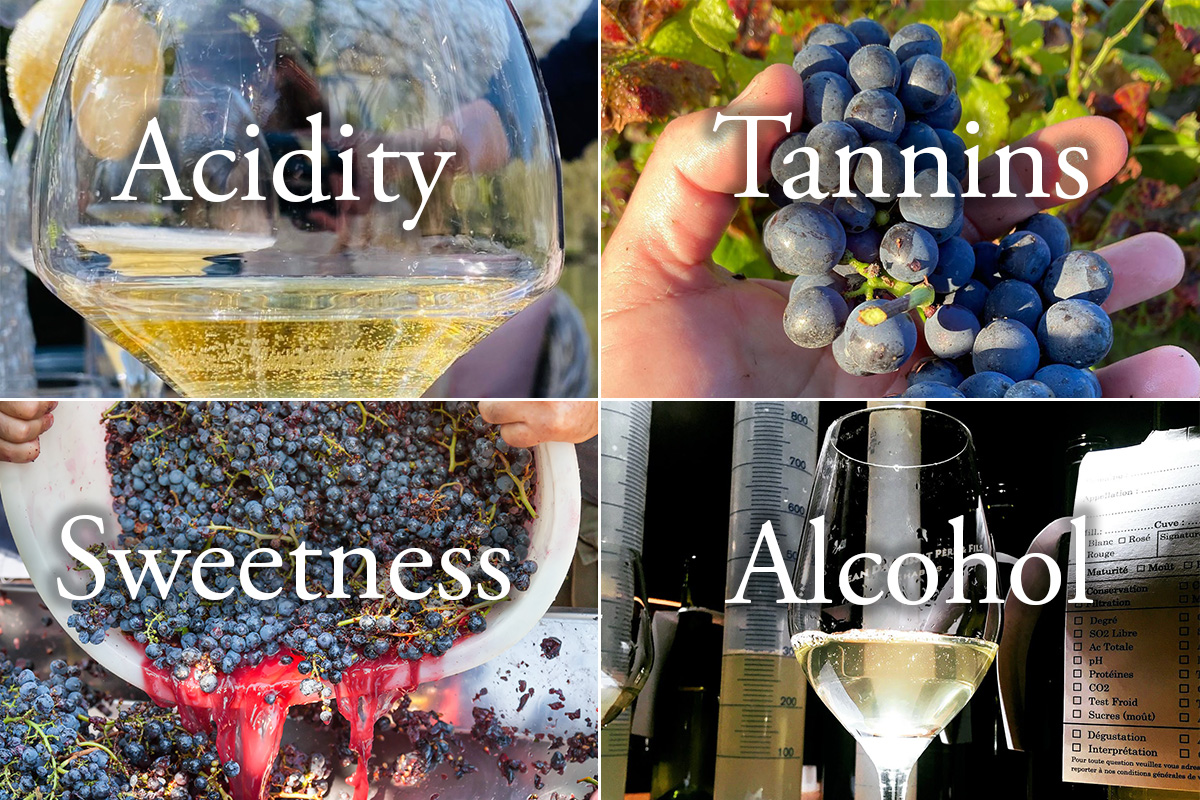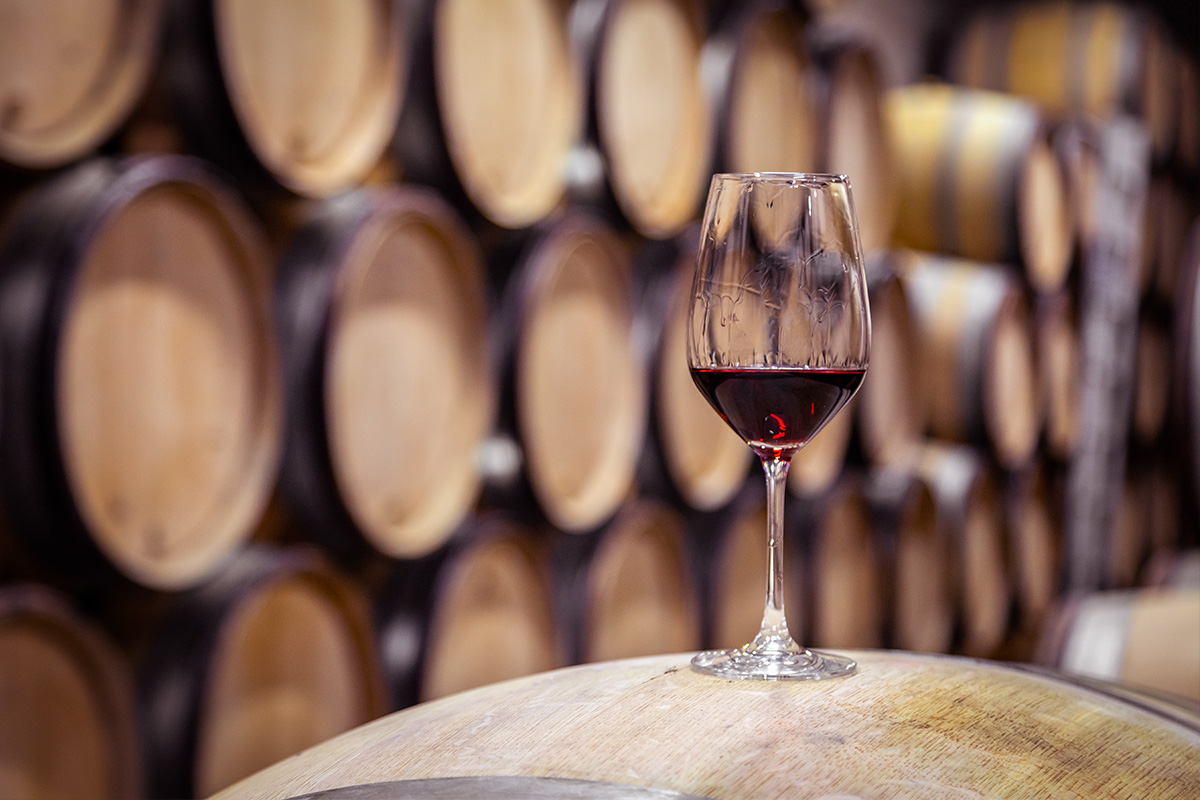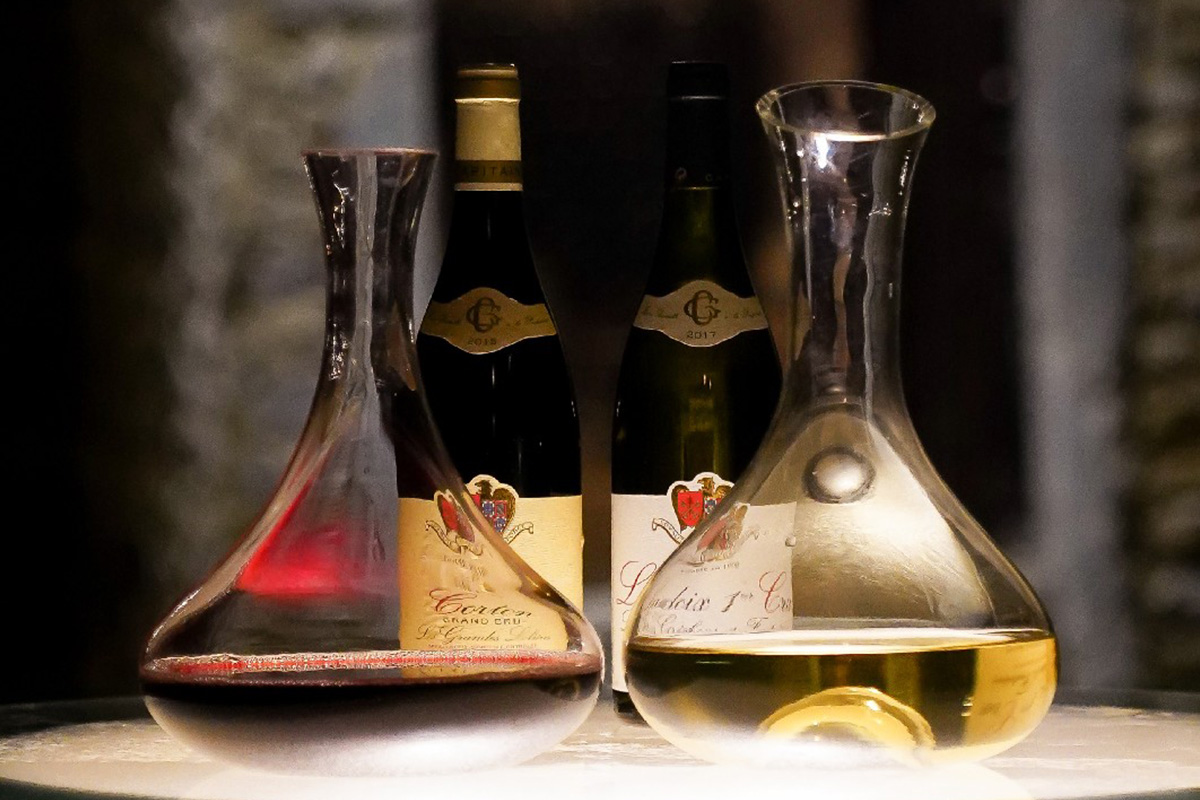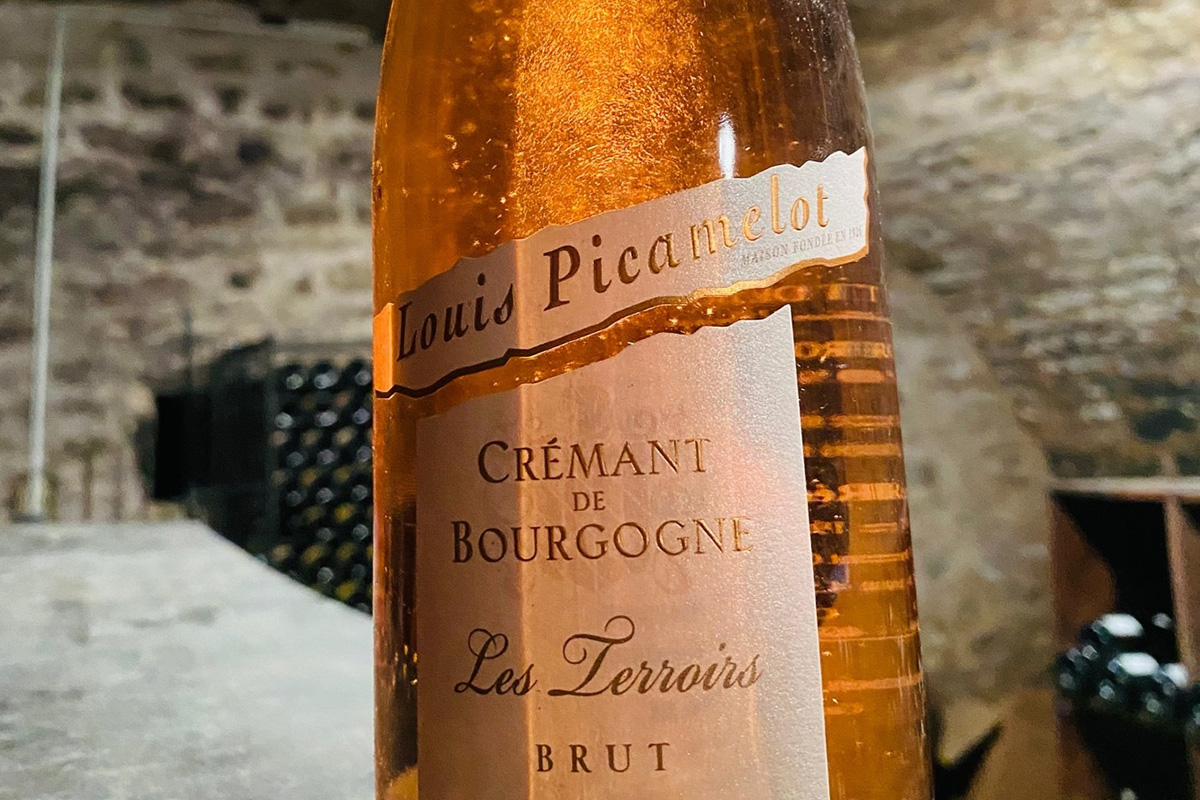
Ever heard of the 4 ‘fundamentals’ of burgundy wine? No matter if not – you’ve probably been appreciating them whilst you’ve been enjoying your favorite wines, whether you can put a name to them or not. Drinking should be mostly about enjoying wines on your own terms, sharing your experiences with friends according to your tastes. Terminology is nice and can be useful, but we’re not writing a scientific paper here!
What are the Four Fundamentals of Burgundy Wine?
That said, it is generally agreed that the four fundamentals of wine are things to be aware of and appreciated. They are, after all, the building blocks of great wines, and how they are balanced is important. The four fundamentals of Burgundy are:
- Acidity
- Tannins
- Sweetness
- Alcohol
Everyone understands what sweetness is and why it’s necessary in some degree, and likewise why the alcohol content is important in choosing a wine. But acidity and tannins are perhaps less clear. This article will explore all of them.

Acidity
We often see the term ‘acidity’ used when talking about wines from all around the world. But is it a good thing, or something to be avoided? We know that in relation to some food or drink, acidity is not a positive characteristic. Isn’t acidic wine just as bad?
Why is Acidity One Of The Fundamentals of Burgundy Wine?
In fact, acidity in wine can be a positive – a positively useful thing. You might know acid by other descriptive words – tart, crisp, or sour perhaps (the opposite of round, smooth wines). All wines have them to varying degrees. Think back to your school days, and those chemistry lesson PH tests you did with acids and alkalis at the two ends of a spectrum. The same scale is at work here. Wines are more acidic than alkali, and that’s thanks to a range of acids present, the most common of which are malic (you may have heard of a process called malolactic fermentation), but also tartaric and citric acids. If you ever pull a cork and see tiny clear crystals stuck to the bottom of it, then these are probably tartaric acid crystals.
Acid serves to make our mouths water – we produce more saliva when we sip an acidic wine, because it helps to protect our teeth from the acid as well as keeping our mouth moist so we can swallow.
The really fun stuff comes when you start to understand how acid impacts the other fundamentals of wine – and how it is itself enhanced or subtly altered by other characteristics. They all end up working together to create the overall ‘personality’ of a wine.
Where Does Acid in Wine Come From?
There isn’t one single thing that gives wine acidity. Some of it comes from the soil the vines are grown in; some of it is dictated by how ripe the grapes were when used to make wine, (all fruits have some level of acidity naturally) other acids are added by the winemaker before fermentation.
But it’s equally common for a vintner to remove acid from a wine, or to convert it into another type of acid. This is done by a process known as malolactic fermentation, where harsher malic acid becomes lactic acid, which is found in milk. This process is often used to great effect in white wines — if you’ve ever had a really buttery white wine which feels almost creamy in your mouth, then this is the process you have to thank.
How To Pair Acidic Wines With Food
They say that opposites attract… well, sometimes an acidic wine is just the right partner for a dish that’s the opposite style to it. For example, a fresher, crisper wine can ‘cut through’ a buttery, cheesy pasta sauce and thus a great food and wine pairing is made. The richer the dish, the more acidic the wine you might want to drink with it.
White Burgundy Wines With Great Acidity
- Gilles Bouton Meursault 1er Cru ‘Blagny’: this wine is a textbook example of what great balance and structure can do for a wine; the rich citrus fruit brings firm acidity, with minerality too, and it’s that structure which keeps the power from being too heavy.
- Jean-Baptiste Ponsot Rully 1er Cru ‘Molesme’: there’s that acidity again, carrying the floral and mineral notes across the whole length and breadth of the palate. This wine demonstrates how the ‘fat’ elements of the wine play against the minerality, and all thanks to the acidity.
- Agnes Paquet Auxey-Duresses Blanc ‘Patience’: this wine shows how the heat of a vintage can dictate acid levels – too hot and the acidity is overwhelmed by high sugar levels, but cooler temperatures create a ‘brighter’ feel – zippy, even, but never at the expense of complexity.
Red Burgundy Wines with Great Acidity
- Michel Rebourgeon Volnay 1er Cru ‘Carelle Sous la Chapelle’: this wine is a good example of how acidity can work to enhance other flavors. Here, although the wine has earthy, dark chocolate flavors, there is an acidity which somehow plays over the top which carries the floral violet characteristics to a long finish.
- Gilles Bouton Chassagne Montrachet ‘Concis du Champs’: a great example of how acidity can hold many seemingly disparate elements in balance together. This wine has plenty of them: pepper, smoke, ripe leaves, pomegranate – but it’s the acid that holds them all together in one coherent structure.

Tannins
Tannins are simply a type of natural chemical compound. They’re found in many natural products, especially their seeds and skins, and taste somewhat bitter (astringent is another commonly used word). Red wines contain more tannins because the skins are left in the wine for longer during the process called maceration. There is a vast range of tannins in all wines, including white and rose, and these levels depend on many things, including how the wines are aged. The word tannin itself is thought to come from the Latin word ‘tanner’, referring to the practice of tanning hides using bitter tree bark.
Grapes with thinner skins have lower levels of tannins (which includes Pinot Noir grown in Burgundy) but those with thicker skins will have higher tannin levels – think of Malbec, Cabernet Sauvignon and Shiraz.
There is evidence that tannins may be good for you, too; they appear to resist oxidation in the body (which is a bad thing and causes cell damage) even more than tannins found in tea.
Why Are Tannins One of the Fundamentals Burgundy Wine and How Do They Affect Food and Wine Pairing?
Because tannins add structure (body) and texture to your wines and make your mouth feel a little dry, tannic wines can be an excellent accompaniment to fatty or rich foods – especially red meats. The molecules of tannin actually bind physically onto protein molecules and remove them from your mouth as you swallow.
On the other hand, if you wanted a wine to go with a bitter dark chocolate dessert for example, then a red wine high in tannins might also work well and complement the chocolate.
The Different Types of Tannins
We’ve said that tannins are bitter, but in fact that’s a little too simplistic a view; in fact, they can come in many different varieties. Some of them are soft and smooth, and Pinot Noir in Burgundy is a very good example of this, meaning that Burgundy wines often have silky tannins which give a pleasing, round feel in the mouth. On the other hand, some tannins are coarse and grainy, and have that typical astringent quality. Young wines in particular have this type of tannin, which goes well with rich food. Then there are the elegant and refined tannins found in wellaged Burgundy wines, which are less noticeable and add complexity to a wine.
How Tannins Interact With Acids
This is where the magic starts to happen. Acids and tannins happily exist beside one another in wine – the acids making your mouth water (imagine biting into a tangy orange) and the tannins drying your mouth out. Over time, you will learn to notice when each of these things is happening and see how they combine in the overall experience of the wine. Then you can look for wines with this flavor profile, such as these:
Burgundy Wines With Great Tannins
- One of the best Burgundy red wines to demonstrate this interaction of tannins and acidity is the Marchand-Tawse Corton Grand Cru. You can tell instantly that this is a great wine because it has a wonderful structure and complexity – all based on that tannin and acidity interplay.
- A fine Burgundy white which demonstrates the same thing is the Chateau de Vergisson Pouilly Fuisse ‘En Charmont’ it has acidity which is balanced by that touch of tannin, which serves to give it a round mouthfeel, such that you almost think you can chew it!
Sweetness
This one is fairly self-explanatory, but for a simple concept it can have a profound effect on the personality of the wine. The amounts range from ‘dry’ (very little sugar) to ‘sweet’ (or dessert wine). An easy way to tell how much sugar might be in your wine is to swirl it in your glass and watch as it falls back down the side of your glass – the slower it does so, and the more it leaves there (the ‘legs’ of the wine) then the sweeter the wine is.
Why Is Sweetness One of the Fundamentals of Burgundy Wine?
How does sugar make its way into wine? Well, there are of course sugars in the grapes themselves, and some of these (not all) transform into alcohol during the process of fermentation. Sometimes, sugar can also be added to wine after the fermentation process, but not very often in higher quality wines. You may have heard the term ‘chaptalization’ the process of adding sugar to slightly unripe grapes, before or after fermentation.
Sweetness can work against the effects of acid in wine, masking them and making them less harsh.
You may think sweet wines present a challenge in terms of how to pair them with food, and that they can only really go with desserts. Well, in fact sweet wines are also good to be drunk with spicy foods, because sugar absorbs capsaicin (what makes chillis hot).
Anyone who likes Asian food will also know that sweet and sour flavors go well together, as do sweet and salty, so in fact sweet wines are very versatile when it comes to food pairings.
But as with everything about wine tasting, the way you perceive sweetness may be very unique to you. Each of us has a different palate with a different makeup of saliva, which may have higher or lower sensitivities to sugar, tannins and other molecules.
Examples of Sweetness in Burgundy Wines:
- Jean Dauvissat Pere et Fils Chablis 1er Cru ‘Fourchaume’: Wines from Chablis are not sweet per se, but they demonstrate how sweetness can be nuanced. This wine is a great example of how sweetness can combine with acidity to make amazing things happen on your palate – it has a sort of sweet, lemony acidity. Chablis from the right hand bank of the River Serein are rounder, riper and sometimes sweeter because they have more hours in the sun than their cousins on the left bank for the same river.
- Domaine Joliet Fixin 1er Cru ‘Clos de la Perriere’: this wine also demonstrates a more subtle sweetness – a sweet, fresh raspberry fruit flavor and afternotes of cherry.
- Louis Picamelot Cremant de Bourgogne Rose NV: to find the most pronounced sugar and sweetness in Burgundy wine look no further than Cremant de Bourgogne. Grape sugar called “liqueur d’expédition” (brut) is added after fermentation and just before final closure of the bottles. The result is still balanced though, and very elegant.

Alcohol
This last of the fundamentals of Burgundy wine is well known to all, though you might have heard the term ABV used instead (Alcohol By Volume), meaning the amount of ethanol present. Alcohol is present because it is produced from sugars during fermentation.
Dessert wines can be as much as 20% ABV, and some strong reds around 15.5%. Average levels are around 11.5 - 13% (which is where Burgundy wines mostly come in) however there can be a lot of variation, depending on the type of wine and production process. At the lower end of the scale are wines below or around 10% ABV, which includes some Rieslings and Muscadet wines. In some countries, laws exist to require wines to have certain ABV levels.
Grapes grown in warmer climates are likely to be riper and have more sugar – therefore they have more alcohol when the sugar is turned into alcohol by yeast during fermentation.
Why Is Alcohol One of the Four Fundamentals Of Burgundy Wine?
Alcohol matters for several reasons; firstly, because you need to know how strong the wine is and what sort of effect it’s likely to have on you, depending on whether you like stronger wines or not. But secondly, because it will inform the choices you make about how to pair stronger wines with food. For example, bear in mind that alcohol in wine creates a warming sensation on your palate – therefore, drinking high-alcohol wines with spicy foods is probably not a great idea! But remember also that the food you eat with these wines needs to be able to stand up to them rather than be overwhelmed by them, so rich and meaty dishes should work very well.
That concludes our roundup of the four fundamentals of Burgundy wine. We hope you’ve found it interesting and useful – and that it enhances your wine drinking pleasure for many years to come!
If you like reading articles about how to expand your wine knowledge and get great recommendations from our favorite small-appellation producers, why not bookmark our BurgundyWine.com blog site? Or to read about how to stay at our idyllic manor house amongst the vines and the amazing trips you’ll make and people you’ll meet, click here for our Domaine de Cromey blog.

